Antique Sterling Silver tea sets are one of the dinnerware that survived the Victorian Era due to their unique design and aesthetically pleasing looks. They’re also functional for people who still serve tea like in the good old days, hence the market demand.
Today, there are new brands of tea sets in the market, from sterling silver to silverplate, gold, ceramic, and fine china. On a secondary retail page, you can buy a quality antique sterling silver tea set for $400 – $500.
That’s good. Since you’re here, it means a piece caught your eye, and you’re doing due diligence. We’ll help you identify, value, and trade antique sterling silver tea sets.
Table of Contents
A Brief History of Antique Silver Tea Sets
It’s important to know the history of an antique item as it holds the key to many questions you’ll encounter on your collection journey.
Sterling Silver tea sets existed for the first time in 1790, although its popularity wasn’t until Queen Victoria’s reign in the British empire. As discovered through her journals and people close to the queen, tea time was very important to the monarch.
Her servants attended her with a tea service consisting of a multi-tiered trolley or holding a tray, teapot, teacups, and finger foods or appetizers like a biscuit. Hence, the birth of the tea cart and tea set.
Identifying Silver Tea Set
Knowing the significance of antique sterling silver tea sets, it’s not far-fetched to treat every piece as a potential reproduction or copy. This attitude keeps you alert to fake pieces amongst the original lot and saves you the trauma of wasting money on cheap items.
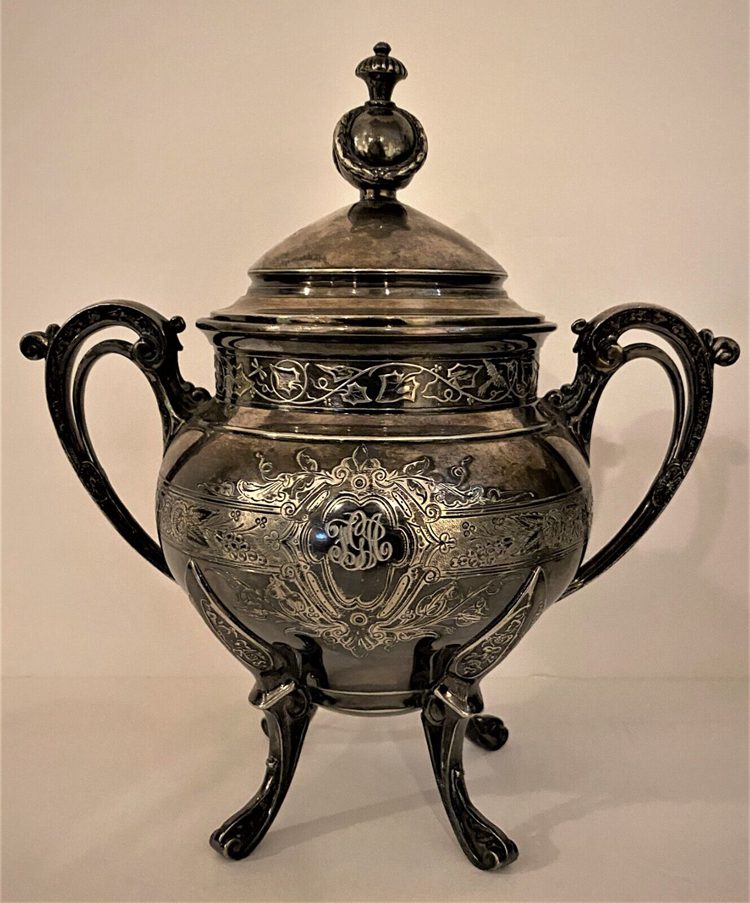
Identifying an antique sterling silver tea set is an art you can cultivate with practice. Once you know the signs to look for, you’ll become an expert in no time. Below are some of the common identifiers;
Assess the Exterior
With Sterling Silver tea sets, you can “judge a book by the cover” in the first identification stage. It should have signs of old age, such as a patina, if it’s the real thing, since antique means 100 years old and more.
Patina is another word for discoloration: dark patches and other slight marks that tell you someone polished that tea set severally.
Once you’re past the aging signs, the next outer identifier is the texture and design. Artisans’ handmade antique sterling silver tea sets give them unique patterns and styles on the exterior. You can use these hand-chased patterns to identify the maker.
Some of these patterns were figural, consisting of animals, foliage, flowers, or people, depending on the maker and the production time. Time, in this case, refers to eras like Art Deco and Art Nouveau, and with antique sterling silver tea sets, they were the latter.
Sterling silver tea sets with unidentifiable manufacturer’s marks are likely customized monogrammed pieces. On the tea set, you’d see a popular family’s crest, initials, or monogram (first letter of the family name).
Other Physical Features
Weight is a key factor in determining the authenticity of an antique sterling silver tea set because silver as a metal is heavy. Many reproductions made in this century are often stainless steel, and that’s lightweight. So, always confirm that.
Does it have a manufacturer’s mark?
Silver Tea Set Markings
Sterling silver tea set markings are arguably the most important identifiers since they tell you everything you need to know about the item. All sterling silver items had maker’s marks called Hallmarks which combined the manufacturer’s name, city/country, and date on the item.
These Hallmarks were necessary to separate sterling silver from other similar materials such as silverplate, and it’s proven useful today. You’d find these symbols underneath the tea set (tray, teacups, and teapot).
Note that American and English Hallmarks are different so let’s start with differentiating their modes of marking a sterling silver piece.
American
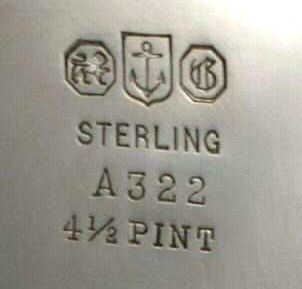
The American method is typical of the US and its surroundings.
Visit the link above for a long list of American Sterling Silver marks by name. American silversmiths signified their names and locations in their marks with letters, numbers, and logos. Keep reading for a breakdown;
Identification by Letters
Letters often signify the maker’s name, consisting of the initials – first name, middle name (optional), and last name.
Identification by Numbers
Numbers tell you the production date of an antique tea set made of sterling silver, but they’re often represented by single letters.
Identification by Logos (Figures)
Figural marks are the most confusing identifications on sterling silver tea sets. They’re made of different drawings, from humans to candelabras, crowns, flora, crosses, arrows, anchors, and animals.
Unlike the English system, the Americans didn’t have a standard marking method on sterling silver items, including antique tea sets. Luckily, experienced collectors have made lists based on noticed patterns.
First, you identify the object and the brand which owns it. Then, you crosscheck the company’s registration date at the Patent Office. You can get the age through the logo by putting all the marks together and reading them as one.
See the table below for a short list of popular sterling silverware makers and their patent dates.
Company Name |
Registration Year |
Gorham |
1868 |
Tiffany & Co. |
1861 |
Whiting Man. & Co. |
1905 |
English

The English method is typical to the UK and its surroundings.
English hallmarks date back to the 12th century, even before Tea Sets were a thing. It started as a means of regulating sterling silverware standards by the Royal Ordinances and Acts of the Parliament, Guild of Goldsmiths (in London), and Guild of Dublin (in Ireland).
Three unique logos make up a single Hallmark – Mark of Origin, Standard Mark, Date Mark, Duty Mark, Import Mark, and Maker’s Logo. The typical order is Maker’s Mark – Standard Mark – Assay Office Mark – (Import Mark) – Date – Duty Mark.
Mark of Origin
The manufacturing town has a unique mark telling the buyer where the tea set was made. See the Table below for more hallmarks for antique tea sets bearing in mind that they didn’t exist until 1790.
All pictures are sourced from Silver Collection, and you can get more from Silver Maker’s Mark UK.
Town/City |
Year |
Logo |
Picture |
Birmingham |
1773 – date |
Anchor |
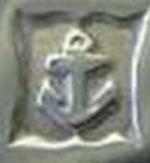 |
London |
1821 – date |
Leopard’s uncrowned head |
 |
Sheffield |
1773 – 1975 |
Crown |
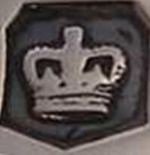 |
Chester |
1784 – 1962 |
An erect sword between three wheat-sheaves |
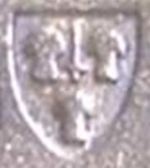 |
Edinburgh |
1483 – date |
Castle |
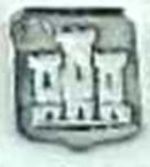 |
Glasgow |
1681 – 1963 |
A Tree, A Fish and A Bell |
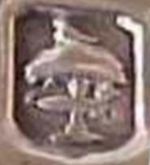 |
Dublin |
1807 – date |
Hibernia |
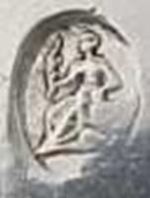 |
Standard Mark
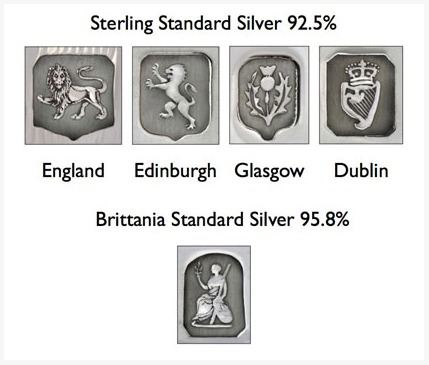
This mark tells you that the tea set in your hand is certified 92.5% sterling silver with 7.5% alloy/copper. All manufacturers’ tea sets had to pass the test at the Assay office, where they’d get the Standard Mark.
Like the maker’s mark, each Assay office had its unique logo, although it wasn’t as many as the former. Think of the major towns and countries in the United Kingdom when assessing this mark. Below is a list of four patterns per city.
London – Lion Passant facing left
Scotland (Edinburgh) – Thistle
Scotland (Glasgow) – Lion Rampant. Note that the Thistle later became all-encompassing in Scotland.
Ireland (Dublin) – Crowned Harp
Date Mark
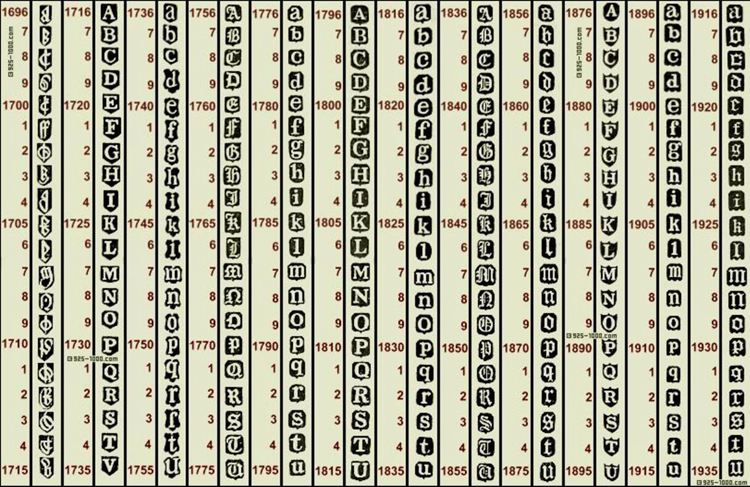
The final mark is the production date, and that’s the best age identifier. These dates don’t come in obvious numbers but letters representing certain periods. These letters also differ based on the country, town, or city. Visit The Gold Bullion for a detailed account.
Duty Mark
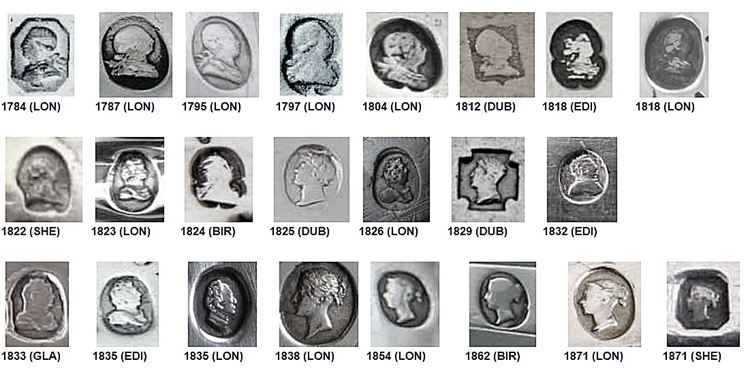
Silversmiths had to pay duty fees to the crown until the 1890s, and their items got an engraved head stamped on the back. Silverware made in Dublin had the Hibernia engraved on the back as the duty mark.
Import Marks
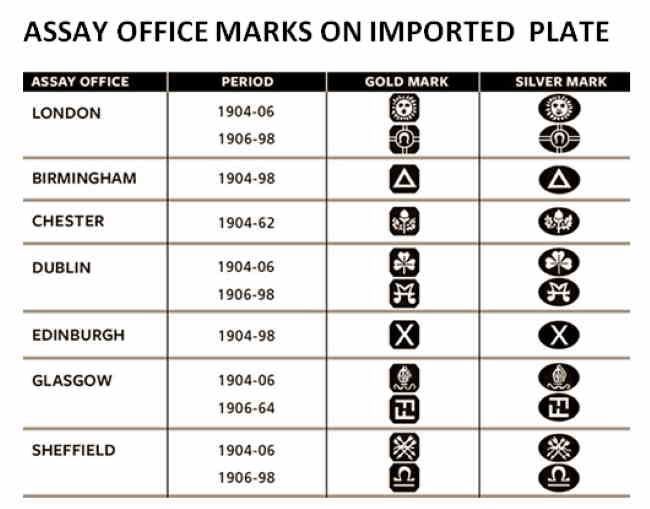
The 1842 Customs Act in the UK states that the British Office must assay all silver and gold items imported into the country, so foreign things earned the “F” mark on the back. That lasted until 1904 when the silver content’s rule changed to decimal values.
The overall sterling silver standard is 0.925/1000, while the British standard is higher at 0.958/1000. So, you’d see only the decimal figures on the silverware without the “1000”. By the 1900s, this mark changed into a unique Assay logo based on the region of the British Office.
Maker’s Logo
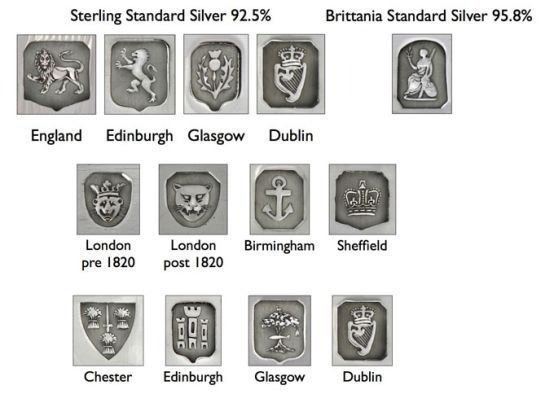
Every maker you’ve learned so far has a unique sign indicating they made an item. These signs were logos before the 1400s, but that century launched the use of the silversmith’s initials formed by their first and last names.
Because these initials could pose confusion, silversmiths added other logos to enclose the letters. They include shields, circles, leaves, and more.
What’s The Component?
Sterling silver earned its name from the almost pure silver component it possesses. Since 100% silver items aren’t feasible due to their soft texture, manufacturers mixed 92.5% silver with 7.5% alloy. So, you may see 925 on the sterling silver tea set apart from SS or Sterling Silver.
Alternate antique silver tea sets that look like Sterling silver tea sets are Coin silver with 80% silver content and silver plate with significantly fewer silver components.
Is Sterling Silver the same as Silverplate?
As you’ve learned, Sterling silver means the tea set has 92.5% silver content, but not all shiny items are sterling silver. Anything without the sterling silver mark is likely a silver plate. Another material that looks like it but isn’t the same is Silverplate.
Silverplate is made of a thin layered silver coating over another metal. Hence, it’s predominantly the other metals like copper, steel, and bronze wrapped with a small percentage of silver. Since it has no melt value, it’s not worth as much as sterling silver which is almost pure at 925/1000.
How Much is a Silver Tea Set Worth?
The average antique sterling silver tea set sells between $500 – $1,000. If you find a rare model with provenance and other value-increasing factors, get ready to spend at least triple that value.
However, the value of the Sterling Silver Tea set varies based on a set of factors, as you’d learn below. Meanwhile, check out the list of the highest-sold antique sterling silver tea sets on eBay between September 9 and October 15.
Silver Tea Set Value
However, all sterling silver tea sets won’t sell at high dollar prices, as they have to fit into certain criteria. These are all the things that make them important and, as such, worth having as a collectible.
They include – the brand, age, quality & condition, design, and provenance. We’ll explain each one individually for you to understand better.
What brand is the Sterling Silver Tea Set?
When you step into a store to buy any item, it’s typical for you to check for notable brands due to their proven quality. The same goes for antique sterling silver tea sets. Research the brands that made a wave during the peak of their popularity and search for those first.
If it was important back then, it’s doubly important now because that’s a piece of history. Also, the chances of extinct companies’ antique tea sets still being in existence are slim. Therefore, any quality brand that no longer produces becomes rare and valuable.
How old is your antique sterling silver tea set?
It’s not a rule that older items are the most valuable, but they have the edge over others due to their longevity. Any sterling silver tea set that’s lasted 100 years and more with little to no damage is worth keeping.
Quality and Condition are Key
Except you want an antique sterling silver tea set for decoration, it must be in perfect (or near perfect) condition to be worth the money. Even if you need it as décor, the tea set’s exterior must be aesthetically appealing to command a decent price.
When dealing with slightly damaged tea sets, check for dents, scratches, and patina. Although they confirm the authenticity of an antique sterling silver tea set, they shouldn’t be irreparable.
Design Details aren’t the Same
Remember, we said antique sterling silver tea sets were often handmade by artisans, so the designs aren’t the same. While the details tell you which brand owns your items, it distinguishes regular pieces from limited editions and specially made designs.
The more unique the detailing on the exterior, the higher the monetary value. Some examples of expensive antique tea set details are Gorham Chantilly, Steiff Rose, and Tiffany & Co. Westinghouse.
Most Valuable Antique Sterling Silver Tea Sets Ever Sold
Antique tea sets made of sterling silver aren’t the only valuable designs; they’re amongst the highest sold ever. Here’s a short list based on auctioned pieces this century.
No |
Brand |
Year |
Price |
1 |
Tiffany & Co. Westinghouse Tea Set |
1890 |
$380,000 |
2 |
Theodore Wende |
1927 |
$181,000 |
3 |
Tiffany & Co. Chrysanthemum |
1891 – 1902 |
$54,012 |
4 |
Tiffany & Co. Customized Tea Set |
Late 1800s |
$22,800 |
5 |
French Art Deco Tea Set |
C. 1925 |
$6,500 |
6 |
Louis XVI St. E Puiforcat Tea Set |
1850 – 1899 |
$4,388.87 |
6. Louis XVI St. E. Puiforcat Tea Set
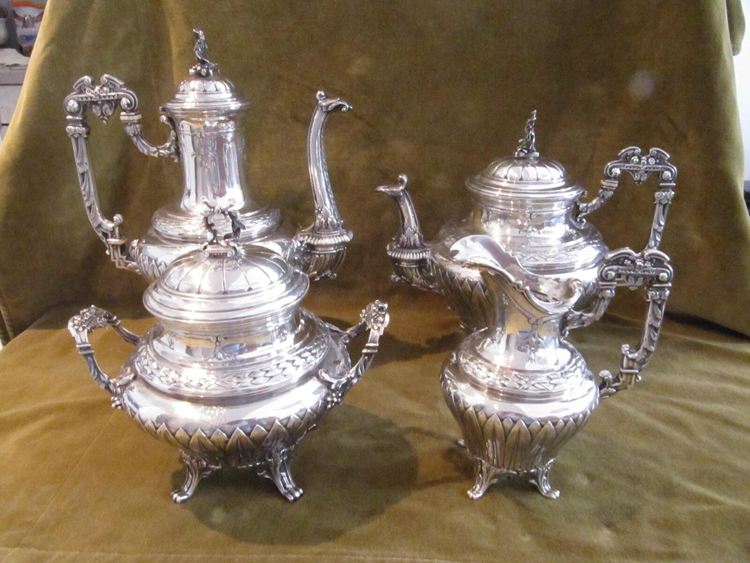
Year: 1850 – 1899
Price: $4,388.87
French silversmith Emile Puiforcat handcrafted this rare 19th-century piece during Louis XVI’s reign. The sterling silver set sold in good condition had some fixable damage, like a loose screw on the tea pot’s handle.
5. French Art Deco Tea Set
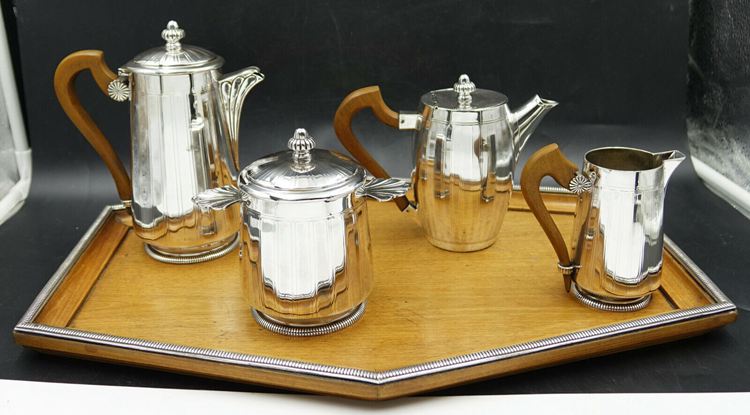
Year: c. 1925
Price: $6,500
Yes, it’s three years away from becoming an official 100-year-old antique but this four-in-one tea set made of sterling silver and wood was the most expensive piece bought on eBay this month.
It’s made in the Art Deco geometric style with a hexagonal tray and fused wood with sterling silver pieces. Upon inspection, you’ll find the French Standard mark, a Minerva head engraved on each tea set piece.
4. Tiffany & Co. Customized Tea Set
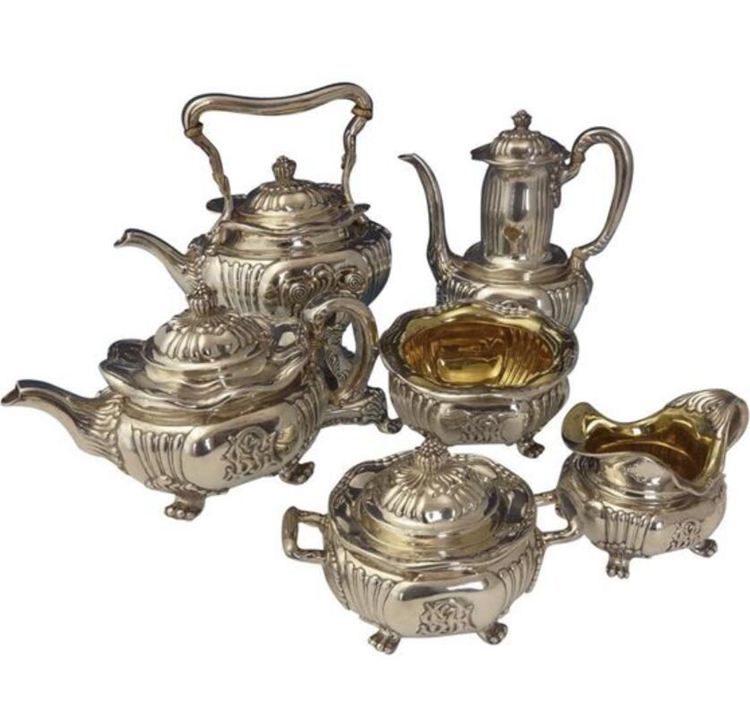
Year: Late 1800s
Price: $22,800
This New York-made tea set comes with an obvious provenance mark. Its inscription reads A Wedding Gift to Sophia Augusta Brown from her Mother, October 7, 1885. It sold at auction in January 2020.
Note that “Sophia Augusta Brown” was a New York socialite and heiress prominent during the gilded age. It makes sense that she had a tea set since she’d have hosted many society parties, both grand and for her inner circle.
The customized inscription was a thoughtful addition from her mother, and the sentimental value carried on to the auction house.
3. Tiffany & Co. Chrysanthemum
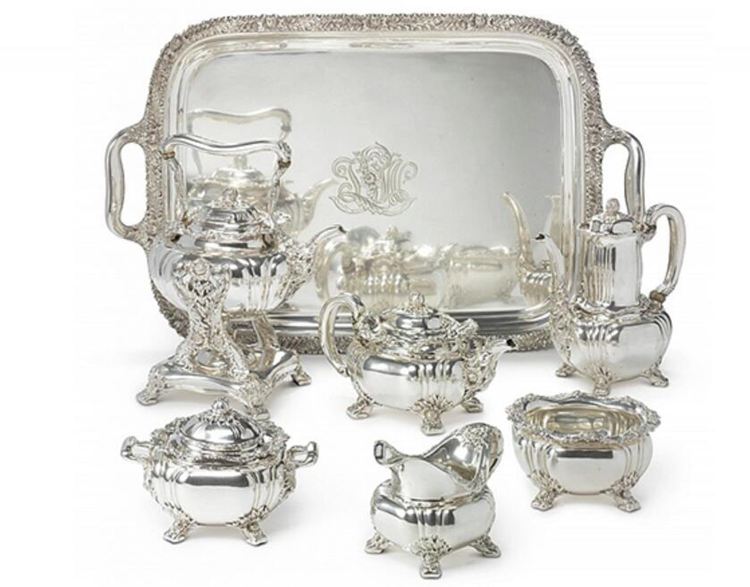
Year: 1891 – 1902
Price: $54,012
This Tiffany & Co. Chrysanthemum sterling silver set, including a coffee service sold at auction in 2013. The 7-in-1 set consisted of a kettle with a burner, teapot, sugar bowl with lid, cream jug, tea tray with double handle, and extras – coffee and chocolate pot plus the waste bowl.
You can recognize it by the signature “T” monogram for Tiffany & Co. on the tea set.
2. Theodore Wende
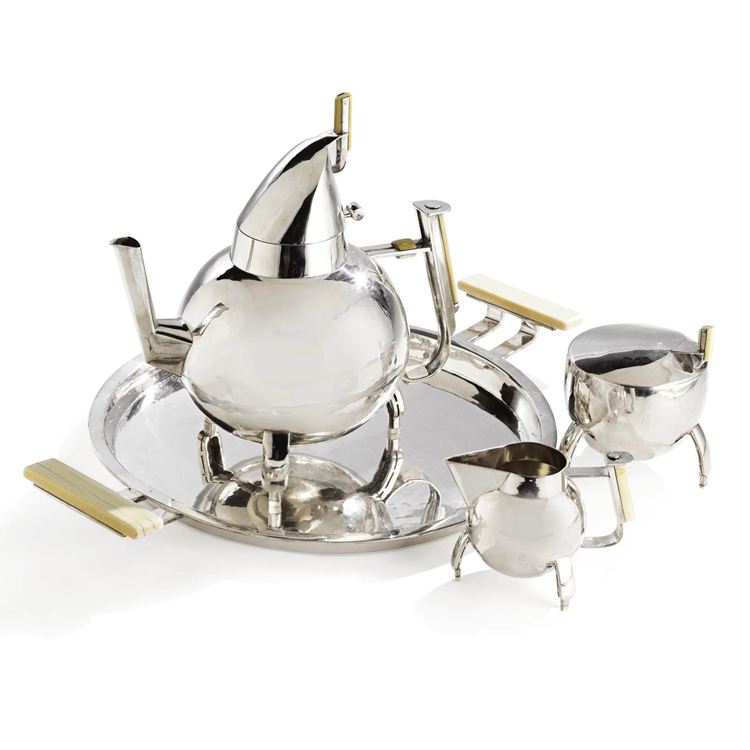
Year: 1927
Price: $181,000
In 2007, a Theodore Wende sterling silver tea set sold at auction for six figures despite being a few years short of the official antique stamp. The unique tea set was part of a collection made in honor of German designs.
1. Tiffany & Co. Westinghouse Tea Set
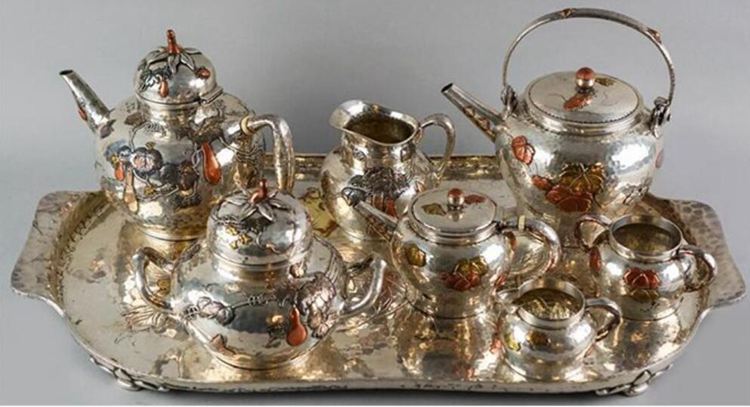
Year: 1890
Price: $380,000
This Japanese-style tea set was sold at auction in 2006 to a silver dealer. It has unique silver and gold detailing on the exterior which is common to the Aesthetic Movement when it was made. They consisted of dragonflies, butterflies, and other insects.
Trading Antique Silver Tea Set
With information on identifying and valuing an antique sterling silver tea set the final important question is where and how to buy or sell. There are some things to consider when the demand is high and who sells authentic pieces.
Where to Sell Silver Tea Set
If you’re an independent seller, the best place to trade is via secondary retail sites such as eBay, Amazon, and Etsy. You’d have to register and fulfill certain criteria to get a verification, but other than that, you’d have access to a wide audience.
If you suspect your antique sterling silver tea set is worth tens and hundreds of thousands, it’s best to use an auction house. Not only would they verify the worth through an in-house appraiser, but they’d also insure it before the sale.
Where to Buy a Sterling Silver Tea Set
You can buy antique sterling silver tea sets in the same places listed above as sellers. The basic pieces are available at local antique stores, online retailers, and garage sales. If you want high-quality items, it’s best to search at auction houses and estate sales.
That’s not saying you can’t strike a goldmine at a dusty old garage sale. You never truly know what an antique sterling silver tea set is worth until you appraise it. Always use the tips in this guide when shopping for an antique tea set.
Final Words
Antique Sterling Silver tea sets are nostalgic pieces of the late 19th and early 20th century and would be great additions to your home collection. However, remember not all shiny silvery tea sets are sterling silver, and you can confirm authenticity using the tips above.
FAQs
Q: Are Silverplated Tea Sets valuable?
Silver-plated tea sets aren’t as expensive as antique sterling silver ones because they don’t have any inherent value. However, they’d fetch a decent $50 – $100 on eBay. It can be worth more than that if it’s a beautiful piece.
Q: Do Countries still regulate silver?
Many countries have stopped the practice since 2003, according to Marks 4 Antiques. They felt silver could be a bargaining tool in the hands of the enemy during the wars.
Q: Is Coin Silver the Same as Sterling Silver?
American-made antique silver is coin silver because it’s the same material used in the minting press. However, it’s not the same thing with sterling silver. Whereas Coin Silver has less purity percentage of 75%, Sterling Silver has more at 92.5%.
Unlike Sterling Silver, it took longer to standardize coin silver, so there’s no fixed percentage. Those made from 1868 are at least 0.750/1000 silver content.





![Where To Sell Antique Furniture In 2022 [Ultimate Guide]](https://www.jacquelinestallone.com/wp-content/uploads/2022/09/Etsy-Your-Place-To-Buy-And-Sell-All-Things-Handmade-600x450.jpg)


